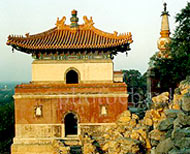 The Summer Palace is set to be rejuvenated and revamped, as part of a cultural construction project set up by the government.
The Summer Palace is set to be rejuvenated and revamped, as part of a cultural construction project set up by the government.
China's outstand symbole, was built in 1750 in the Qing Dynasty (1644-1911). It contains almost every element of ancient China's gardens such as pavilions, bridges, pagodas and boats.
The Summer Palace, first named the Garden of Clear Ripples, has a history of 251 years, beginning from when it was an imperial garden, to now being a park.
It was ruined twice, first in 1860 by the allied forces of Britain and France, and in the 1900s when it was burned by the allied eight powers - Britain, the United States, Germany, France, Russia, Japan, Italy and Austria, which were sent to suppress the anti-imperialist Yihetuan Movement of the Chinese people, dubbed as the Boxer Rebellion in Western records.
When New China was established in 1949, it took the government 10 years to renovate the garden.
In 1998, the Summer Palace was inscribed as a potent symbol of one of the major world civilizations in the World Heritage List of the United Nation's Educational, Scientific and Cultural Organization.
From the 1990s, the government allocated more than 10 million yuan (US$1.2 million) every year for the protection and reconstruction of historical relics in the park.
"We are expecting to restore about 30 scenic spots in the park in the future," said Geng Liutong, general engineer of the Summer Palace.
"All historical relics will receive maintenance periodically," said Geng. "And maintenance will be carried out strictly according to the plan."
According to Geng, there is a balance between the areas that will be maintained and the areas kept open for visitors.
Geng said, it is scientific and rational to repair the scenic spots every 20 years. Experts in the garden have different methods to protect the 40,000 pieces of historical and cultural relics exhibited in the 300-hectare garden.
Of the methods, the construction of the Wenchang Gallery creates a favorable environment for the historical and cultural treasures and for tourists. The gallery exhibits thousands of artifacts, some of them dating back 3,000 years. Inside, all items will be better preserved.
As part of the cultural treasures, the 400,000 trees that also crystallize the essence of Chinese culture will be looked after.
Amongst the trees, 1,600 are more than 200 years old. Every tree has a file and is kept in the garden's database for protection.
However, due to a lack of programming, the tree species were not very well selected to plant in the garden in the 20th century.
Realizing this, the palace authority plans to plant more pines and cypress trees.
In order to restore the original construction, the government has started to move out residents that have occupied the park for many years.
(China Daily 08/13/2001)
